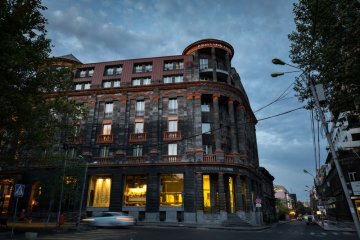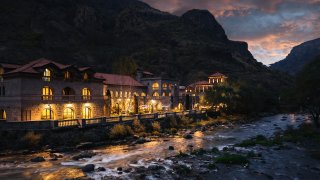TUFENKIAN HERITAGE BOUTIQUE HOTELS AND RESTAURANTS
Welcome to Tufenkian Heritage Hotels, the first Armenian boutique hotel chain. Immerse yourself in the essence of Armenian heritage at our four stunning locations in the country's most beautiful regions, where each hotel exudes its own unique spirit, offering a captivating experience. Indulge in the charm of our exquisitely designed rooms, adorned with handcrafted furniture and renowned Tufenkian Carpets. Delight in the flavors of Western-Armenian cuisine and local specialties at our restaurants, where we foster a high culture of good dining and wine appreciation.
Our hotels

Armenia, Yerevan, Yerevan, Hanrapetutyan street, 48
TUFENKIAN HISTORIC YEREVAN HOTEL
Welcome to Tufenkian Historic Yerevan Hotel, a haven for discerning business travelers, families, and individuals seeking authentic design and utmost comfort. Embracing Armenian traditions, we cherish natural materials like metal, basalt stone, and wool. Our central location near Republic Square and Vernissage arts & crafts market ensures easy access to attractions. Relax in rooms adorned with exquisite Tufenkian carpets, evoking a cozy, home-like ambiance. Experience our swimming pool, conference hall, and Tufenkian carpets' showroom. Indulge in the culinary delights at Kharpert restaurant, where jazz serenades intimate dining. Discover our passion for wine culture and locally-sourced, quality cuisine. Join us for unforgettable memories and heartfelt service.
from 47 050 amd /night
Book
Armenia, Lori region, Dzoraget village
TUFENKIAN AVAN DZORAGET HOTEL
Perched on the idyllic banks of the Debed river in Dzoraget canyon, Tufenkian Avan Dzoraget Hotel beckons with its medieval chalet allure crafted from captivating basalt stone. Immerse yourself in an array of activities, from unwinding by the pool and hot tub to exploring nearby attractions like Haghpat and Sanahin monasteries.
Indulge in the flavors of Western-Armenian and local cuisine at our restaurant, where fresh local ingredients and inventive flavor combinations ignite the palate. With a wealth of amenities, including a conference hall, banquet facilities, and a serene garden, Avan Dzoraget Hotel offers an exceptional escape for unforgettable family holidays, weddings, and the exploration of the remarkable Lori region.
from 37 000 amd /night
Book
Armenia, Gegarkunik, Tsapatagh village
TUFENKIAN AVAN MARAK TSAPATAGH
Experience tranquility at Avan Marak Tsapatagh Hotel, situated near the serene shores of Lake Sevan. Our hotel offers a peaceful retreat in a picturesque setting, just a short stroll from the lakeshore. With 33 comfortable rooms and breathtaking views, it's the perfect escape. Start your day with a farm-to-table breakfast, including our heavenly apple roll made with locally grown apples. Relax in the outdoor heated pool, hot tub, and sauna. Explore the surrounding area with hiking tours and bicycle rentals, or enjoy complimentary access to the nearby private beach for kayaking and swimming. Indulge in exquisite cuisine at Zanazan Restaurant, located just a few minutes' walk from the hotel. Avan Marak Tsapatagh Hotel is open from April 15th to October 1st, offering an unforgettable experience by Lake Sevan.
from 37 000 amd /night
Book
Armenia, Tavush Province, Dilijan, Sharambeyan Street, 1
TUFENKIAN OLD DILIJAN COMPLEX
Transport yourself to the enchanting past at Tufenkian Old Dilijan Complex. Situated in Dilijan's reconstructed old quarter on Sharambeyan Street, our hotel captures the essence of the late 19th century. Immerse yourself in the historic ambiance of our Ananov guest house, featuring rooms adorned with handmade woolen bedspreads, wooden furniture, and subdued lighting. Indulge in the culinary delights of Haykanoush Restaurant, housed in a separate building, offering not only Western-Armenian cuisine but also a captivating dining experience. Discover Dilijan's rich heritage as you explore the specialized workshops and studios, reviving arts and crafts in this vibrant historical district. Experience a journey through time at Tufenkian Old Dilijan Complex, featuring 18 unique rooms for your comfort and enjoyment.
from 37 000 amd /night
BookFor your convenience
Rich continental breakfast
Free Wi-Fi
All our premises have high speed Wi-Fi on the total territory of the Hotel.
Decoration
All rooms are decorated with famous Tufenkian carpets hand-made at Tufenkian artisans.
Daily cleaning service
Heating system available
Hygiene amenities
All rooms are non-smoking
Towels set
Flat screen TV
Free bottled water
Tea & Coffee in the room
Loyalty program
- Free transfer from the airport when booking on the web site
- Catering service
- Activities & excursions
TUFENKIAN HERITAGE BOUTIQUE HOTELS AND RESTAURANTS
- Tufenkian Carpets room decoration
- Slippers in the room
- Rich buffet breakfast
- Concierge service
- Daily room cleaning
- Free Wi-Fi
- Satelite TV
- Free bath accessories
- Parking available
- Restaurant & bar
- Luggage storage
- Picturesque location

